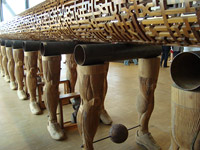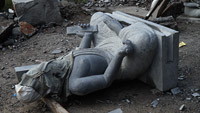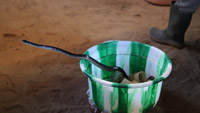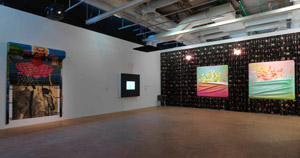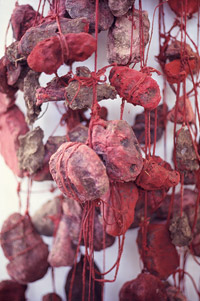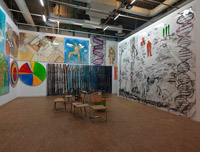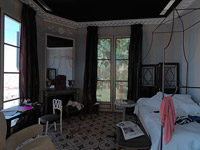Paris-Delhi-Bombay…
India through the eyes of Indian and French artists
From 25 May to 19 September 2011 - Gallery 1, level 6
Nalini Malani, Remembering Mad Meg, 2007-2011
Video / shadow theatre
Introduction: art and Indian society 
Even though it is the world’s largest democracy and a leading emerging economic actor on the contemporary global scene, India remains largely unknown to the French public, and even more so its artistic scene despite the fact that it has been highly effervescent over the last two decades. With the exhibition Paris-Delhi-Bombay …, resulting of an unprecedented collaboration between India and France, the Centre Pompidou invites visitors to discover Indian society through a confrontation of perspectives held by Indian and French creative artists.
View of the exhibition, Centre Pompidou, 2011
At the centre of the documentary room, Tara, a sort of icon of the contemporary Indian woman, by Ravinder Reddy
The exhibition space is organized around a circular documentary room, at the centre of which rises the monumental head of Ravinder Reddy, Tara, a sort of icon of the contemporary Indian woman. Texts, photographs, television coverage, graphic documents, posters referring to the main dynamics, the structuring elements and the landmark events which have shaped the India of today ever since it gained its independence in 1947. Six themes have been taken up: politics, urban development and environment, religion, home life, identity and arts and crafts. They are the result of a considerable amount of work conducted under the aegis of the curators, Sophie Duplaix and Fabrice Bousteau by a research group, sociologists, political scientists, philosophers and anthropologists from the two countries as well as art historians whose works also feature in the catalogue.
After the themes revealed in the central hall, the public can move around freely in the space and head towards the blocks indicated by pictograms [see the plan given below]. The works of Indian and French artists cohabit each sequence.
Among the fifty odd exhibited works, no less than thirty have been produced specifically for this event.
Plan of the exhibition
Architect-exhibition designer: Corinne Marchand
Download plan of the exhibition (PDF, 900ko)
 Politics
Politics 
Issues such as the colonial past, the border issue, conflicts and violence can be seen in the works of many Indian artists. Crystallizing all these aspects, the Partition between India and Pakistan dating back to 1947, at the time of independence, features among the recurring subjects and lies at the very core of their preoccupations. A major event in contemporary Indian history, it not only had significant political and social repercussions but also an emotional and intimate impact on the people and families who experienced it, as Rita Kothari emphasizes in the exhibition catalogue1.
Same is the case with Nalini Malani, whose work Remembering Mad Meg is quite undoubtedly one of the hallmarks of the exhibition.2
Nalini Malani, Remembering Mad Meg, 2007-2011
View of the installation in the exhibition, Centre Pompidou, 2011
Video / shadow theatre
Three animation videos, seven painted Lexan plastic cylinders, steel frames, light, engines, sound
Three video projections, seven painted plastic cylinders, steel frames, light, engines, sound… As many ingredients which make up a disquieting theatre of intermingling shadows, images and sound, an environment paying tribute to Mad Meg, a character from a painting by Pieter Bruegel, Dulle Griet. In the painting of the Flemish master, the helmet wearing female figure is crossing a field of ruin inhabited by strange creatures and where women confront soldiers. Thus, for Nalini Malani, Mad Meg incarnates women who are committed to causes, who are activists, combative and who are instrumental in bringing about change in contemporary India.
Such as the magical lanterns bearing the sparse images painted by the artist on their side: fish, fire arms, bits and pieces of human body, imaginary creatures, mythological scenes… the seven cylinders are moved by a regular rotation which lends the installation a dimension of eternity and hypnotic intensity, with "moments" which are forever renewed. Video projections traverse the images and muddle up the points of reference permanently, and give rise to unexpected encounters between the pictures, akin to those that go through and fracture our mind. The sound alternates between voices, human and animal cries, chants and rhythms whipped up to a frenzy by percussions, and when it reaches a crescendo, there is a feeling of a "disquieting strangeness" that this work arouses3. Drawing as it forcefully does intimate deep-seated sentiments of violence and destruction, it echoes the communal, religious and political strife witnessed in India today, the main victims of which are the womenfolk of the country.
Alain Declercq, Borders/Pakistan, 2010
12,500 shots on black melamine panels, 280x621 cm
On an entirely different mode, and almost with a reverse approach, Alain Declercq also got interested in the issue of Partition. Just like most of the French artists invited to take part in this exhibition, he went to India. Once there, he explored the border area with Pakistan, and took several photos in order to manage to capture an image. Revisiting on this occasion his interest in power equations, his desire to play with illegality and to brush with danger while producing his works, he attempted to get as close as possible to the L.O.C. (Line Of Control) in the particularly sensitive region of Jammu-and-Kashmir. As is often the case with Alain Declercq’s works, risk taking is an integral part of his exhibited work.
For Borders/Pakistan, he has selected one of the photographs taken during his exploration of the area and he reproduces it with the help of 12,500 bullet impacts on black melamine panels. "The simplified pattern gives a few keys to the reading of a border image: a watchtower, or even a fence, reinforcing the silent violence which emanates from the work."4 The artist thus draws up the dark silhouette of a no man’s land living under permanent tension.
 Urban development and environment
Urban development and environment 
After the theme of conflict dealt with in the block devoted to "Politics", the environment block gives yet another key to unravel contemporary India. In fact, for a number of years now and with even more intensity ever since liberalization of the economy took place in the ‘90s, the country has witnessed enormous urban growth. Slums which figure among the biggest ones in the world are mushrooming such as the Dharavi slum, entire areas of which have been reconstituted in the exhibition by Hema Upadhyay5. Rural areas also undergo the consequences of globalization, in particular the pilfering of natural resources6 and the installation of polluting industries.
Peri-urban landscapes which have come up are revealed in the video installation put up by Raqs Media Collective, while Alain Bublex draws his inspiration from the omnipresent makeshift arrangements which evokes the highly specific face of Indian cities, especially in areas inhabited by the working class.
Raqs Media Collective, Strikes at Time, 2011
View of the work in the exhibition, Centre Pompidou, 2011
Diptych video, HD DV, synchronized sound
Since around ten odd years the Raqs Media Collective7 has contributed towards implementing actions directed towards alternative education in several localities of Delhi under the name of CyberMohalla8, in collaboration with a local NGO. With artists, writers, performers, photographers, bloggers and geographers, it has developed a device which impels the youth to develop their thoughts and their creativity. The video installation Strikes at Time9 is the by-product of this experiment, associated with the collective’s interest in the book written by the French philosopher Jacques Rancière, La Nuit des prolétaires, translated in Hindi in 2009.
Rancière’s book narrates how the qualified workers of the 1840s eluded their time schedule, and especially the work/rest cycle imposed on them, by making use of the night to produce activist and committed texts. Refusing to consider themselves as being tools of production subjected to a forced social and political order, they regained control over their body and their individuality in this manner.
Projected on the main screen of the installation, the main character of the film is a man in worker’s clothing, his face painted blue. Snatches of sentences drawn out from a personal diary give an account of the day’s happenings with a great deal of brevity, regularly punctuated with a sentence: "Everything else is just as usual". Reflections with a philosophical bent from artists and a few sentences extracted from Rancière’s book are inserted here and there. On the screen, industrial settings by night follow one another as well as views of production units (factories, workshops) lying in a state of neglect.
Right next to the main screen, as an aside, another smaller screen broadcasts the images of the pages of a note pad, with the Hindi translation of the broadcasted texts on the first screen, alternately with images of a van criss-crossing a wasteland. Through this installation which offers a meditation on the alienation of labour, man is invited to take over control of his life and question his presence in the world. Night is no longer the space for refreshing sleep but the space where everything becomes possible.
Alain Bublex, Contribution #2 (Delhi Cold Storage, notes & hypotheses [of work]), 2010-2011 (details)
250 colour photographs, 20x26 cm each
It is in this environment constructed by men in the course of small touches imposed by their necessities that Alain Bublex evolves. During his stay in India, in Delhi, he proceeds by photographic note taking. Wires stretching all along the walls or above the streets, makeshift connections, tarpaulin sheets spread out or umbrellas hung for getting a bit of shade, tables and chairs extended to the public space, so many are the "singular details observed in the urban entanglement of localities inhabited by the working-class population"10 which catch his attention.
From these images he extracts elements which become structuring and significant elements through his manner of highlighting certain aspects. Entanglement of wires, hung umbrellas, bed sheets spread out to create shade, hybrid vehicles, etc. The computer images thus produced, redrawn in black on a white background, complete the first panel. Last but not least, in a final work involving the manipulation of images, and faithful to his previous works, he offers the vision of an "Indian style" Centre Pompidou. Tarpaulin sheets are spread above the passageways of the building, wires lie hanging right in the middle of the rooms of the museum, wedges support the bases of the works, an accumulation of shop signs and posters saturate the reception area of the exhibition Paris-Delhi-Bombay… Through these images which are themselves the product of a makeshift arrangement, the precarious installations of the streets of Delhi end up making the Centre Pompidou more lively, less smooth sailing, more inventive, and in the process less "institutional".
 Religion
Religion 
Religion, beliefs, and rites are omnipresent in Indian society and leave an imprint especially on the representations that we hold of them sitting here in France. In the exhibition, this angle of approach was especially of interest to the French artists. On this topic, the Indian artists come across as being much more discreet. Or they hold a slightly off beat view, like Riyas Komu whose main area of interest is the world of football, often compared in his logic to religion in the reaction it invokes within society at large.
Riyas Komu, Beyond Gods, 2011
View of the exhibition, Centre Pompidou, 2011
Recycled wood, iron and bronze, 188x993x96 cm
Spectacular, as much for its dimensions as for the work and the know-how required to create it, his work entitled significantly "Beyond Gods" is a monumental wooden sculpture of eleven pairs of legs of football players supporting a long sculpted pipe. Between the legs of the players, wooden frames resembling television screens integrate the heads of French players: Zidane, Anelka, Thuram…
Not belonging to Indian culture per se, football has however shown signs of development over the past few years under the influence of globalization. And furthermore, in the aftermath of the 1998 World Cup, the identity of France is often embodied by the victorious French team in the eyes of Indians. Riyas Komu’s work also contains an underlying critical dimension, as it invokes these football players who are praised to the skies and yet at the same time stigmatized for their origins. Legs in ideal proportions, sculpted with great care to detail, bearing the weight of the strange pipe about which we do not know if it evokes a long sighted vision (allowing to project one’s eyes far beyond) or an oil pipeline (transporting natural resources which in this case would be the talent and energy of the football players, often hailing from the underprivileged sections of society), are however represented as "tormented souls", at once invoking the anatomical perfection of the muscles and tendons, the mechanical dimension attributed to the body of sportsmen, and the sufferings of the raw flesh.
Camille Henrot, Le Songe de Poliphile, 2011
HD video, stereo sound, 9’30’’
Camille Henrot’s work borrows its title from a mysterious book dating back to the late 15th century, Le Songe de Poliphile, a kind of initiatory narrative which subsequently inspired a number of writers, artists and thinkers. Poliphile pursues Polia, the loved being, across gardens, temples, palaces, ancient ruins and wild forests. While he is just about to kiss her, Polia vanishes and Poliphile understands that his travel was nothing but a dream… A trip to the core of the unconscious, therefore, which is what Camille Henrot also realizes in her own manner when she goes to India, for the exhibition. This is testified by the quotation of the Indian psychoanalyst, Sudhir Kakar, as an epigraph to her film: "India is the unconscious of the Western World".
The artist opts to explore fear, through the intermediary of the animal which embodies this sentiment with the utmost intensity: the snake. "An ambivalent symbol in the East just as in the West, at once dangerous and prophylactic, [it] embodies the life drive and the inseparable creation of fear."11 Through images filmed in India and France, in a laboratory, temples, museums, or at the home of snake hunters, and also images drawn from films and comic strips, Camille Henrot reweaves the links between civilizations which we would have thought were poles apart. Her work also helps us penetrate into the core of a collective unconscious which perhaps goes beyond cultural contingencies.
 Home life
Home life 
Family continues to be a structuring element of Indian society to a large extent even today and one of the places which offers the strongest resistance to globalization. The maintenance of traditions, even among the middle classes which show a tendency to become westernized, is particularly significant in India insofar as the globalization phenomenon is concerned.
The Indian people’s relationship with food which brings with it notions of what is pure and impure, the issue of marriage (arranged and governed by the dowry system), the taboo of sexuality are issues that are taken up in the exhibition solely by Indian artists. Since these are domains that are far too personal, and entail highly "reserved" spaces, it was much too difficult for the French artists to master this domain from outside and hence take up these issues.
View of the exhibition, Centre Pompidou, 2011
On the right: Thukral & Tagra, Kingdom Come IV (Group) and Kingdom Come V (Group), 2011
Acrylic and oil on canvas hung on foam
On the left: Atul Dodiya, Mahalaxmi, 2002
Enameled painting on metallic curtain, acrylic paint, marble powder on canvas, 275x183x35,6 cm
Created by Jiten Thukral and Sumir Tagra in 2009, the Thukral & Tagra Foundation took on the mission of contributing to the fight against AIDS in India, by participating in the dissemination of knowledge on HIV and in sex education for youth and their families. Paradoxically, while sexuality continues to be a taboo subject in India, erotic images, whether they concern representations of deities12 or the Kamasutra13, are an integral part of traditional Indian culture.
With the freedom granted by artistic creation, Thukral & Tagra reuse this traditional iconography, represent it in pastels or embroider it on curtains and on bed covers by adding instructions to use condoms. In this fashion they allow Indian society to go back to its historical heritage, so as to be able to act in a responsible manner in the face of the danger posed by AIDS in contemporary society, a danger which is only aggravated by society’s rejection of entertaining any discussion on sexuality.
The funny and joyous images are far removed from pornography that one may be led to label them as. They truly display a wish to play down society’s equations with sexuality, which form the basis of Thukral & Tagra’s work.
Not far from these cheerful images, yet another face of contemporary Indian society is proffered to the visitors. On a half raised iron curtain, a colourful representation of Maha-Lakshmi, the Hindu Goddess of Wealth, smiles at us in an idyllic setting. Two of her four hands hold lotus flowers, from the third one rice flows while her fourth hand seems to beckon us in a tender gesture. This metal awning is the spitting image of one of the numerous awnings of Indian shops which adorn Indian streets at the closing time of shops.
The painter Atul Dodiya uses it here to reveal a tragic scene, the reproduction of a photograph which appeared in the press, of a group suicide, by hanging, resorted to by young women whose families had been unable to pay dowry. This image appears when the iron blind is opened.
The press cutting, magnified by the format (around 1.50x2 m) changes its status here and deals us a blow with its terrible truth. The effect is further enhanced by the contrast with the image of the goddess whose joyful face remains visible even when the blind is completely raised. Maha-Lakshmi seems in this case to be contemplating the scene with a distant smile that one hesitates to attribute to embarrassment, to benevolence, or to utmost indifference.
 Identity
Identity 
The issue dealing with the status of women is very present in the sequence devoted to the theme of identity, especially in the documentary room where it is taken up through a series of posters created by Indian collectives mobilized for defending women’s rights. This theme is also taken up under the angle of gender and sexuality related issues, subjects that are particularly taboo in Indian society.
Here, it will be interesting to compare the works of two artists, both of whose works are devoted to the third gender embodied in India by the hijras14. We are referring to the works of the French artist Kader Attia and the Indian artist Tejal Shah. "Socially defined as being almost women", invited for ritual purposes during marriages and childbirth, hijras are in a certain manner recognized as being indispensable for the proper functioning of society. Their living conditions are however highly insecure and difficult. They are estimated to account for between five hundred thousand and a million people in India.
Kader Attia, Collages, 2011
Video installation in three screens
HD video in DV format, sound, around 67’
Right from the slide show La Piste d’atterrissage devoted to the transsexual Algerian community exiled in Paris, that he crafted in 2000, Kader Attia has been attached to exploring the transgender domain in his artwork. He has been able to combine his approach as an artist and the order given to him for the exhibition in a particularly relevant manner.
The video installation entitled Collages orchestrates, on three juxtaposed screens, a meeting of transsexuals from Paris, Algiers and Bombay. Accompanied in this project by his friend Hélène Azera, a French transsexual, an activist and journalist, he set off to meet with the community of hijras of Bombay. Out of the exchanges which took place between them, combined with the highly moving narrative by Pascale Ourbih on her life in Algeria, was born an evocation of transgender which goes far beyond solely sexuality related issues and thus arises a far more in-depth reflection on the relationship between tradition and modernity, between the East and the West.
Tejal Shah, Untitled (On Violence), 2010
Multimedia triptych
Video screen, digital photography on archival paper and text on LED panel
Not far from Attia’s work, the photographs taken by Tejal Shah seem to evoke an idealized world wherein hijras pose, embodying fantasized characters. In this series entitled Hijra Fantasy, the artist takes it upon herself to give life to their dreams. The difficult reality of their existence which, despite a certain social recognition, often forces them into prostitution and exposes them to violence, comes out very strongly in the highly artificial nature of the images thus produced.
As a counterpoint to these dreamy lives, the installation Untitled (On Violence) no longer leaves any scope for doubt. At the centre, a photograph shows a hijra lying on the ground in a park, badly bruised. A policeman, with just his legs and torso visible, just three-fourth of his body having been shot by the photographer, stands towering over her and flashes a torch on her. While we think that he is getting ready to rescue her, our eyes begin to discern in the darkness of the photo a squirt of urine, and this vision gets confirmed by the wet face and chest of the victim.
On the wall to the right, a screen displays the face of another hijra disfigured by the blows. While being filmed, she stands facing the camera but does not say anything, but her silence is even more violent than mere words. The words can be found on the opposite wall (to the left of the photograph). Scrolling down on a backlit panel in red letters, the narrative of the aggression takes on the strange appearance of a message for information purposes broadcast in the public arena.
 Arts and crafts
Arts and crafts 
After the core subjects dealt with in the first five sequences of the exhibition, the last one, which is devoted to arts and crafts, may seem to be bizarrely out of place. However this is not the case at all. In fact, arts and crafts occupy a central place as much in society as in the work of contemporary Indian artists. The attention given to objects, materials, their manufacturing and their usages is crucial to Indian culture, and one should actually say in Indian cultures at this point, given the overriding importance of the multiplicity of popular arts and traditions in this country where more than 600 different communities rub shoulders with one another15.
Sheela Gowda, Gallant Hearts, 1996 (detail)
Cow dung, pigments, string, 304,8x38,1x20,32 cm
Sheela Gowda forms a part of the brood of artists who witnessed a significant change in their practices in the ‘90s in conjunction with the upheavals that India went through at that time. A figurative painter previously, she started resorting to materials stemming from day-to-day life in order to deal with subjects linked to the Indian society in the throes of transformation.
Among the initial works that she crafted based on this principle in the ‘90s, Gallant Hearts takes on the appearance of a red garland crafted with bits of string and hung on the wall. The "hearts" connected with one another are made with kneaded cow dung coated with a red pigment, the kumkum, used in religious ceremonies and applied by Hindus on their forehead. As for the cow dung, far from what it might stand for in the Western world, it is a sacred matter used in rituals and also in daily life as fuel or for coating the floor and the walls of houses.
The paucity of materials, combined with their nature which is both sacred and reserved for day-to-day use, gives this work a surprisingly powerful and a highly emotionally charged dimension. These hearts pressed between the artist’s hands, crushed and kneaded, carefully strung together, suggest a disturbing violence, exerted with love, or a form of compensation for enormous sufferings that one has had to put up with.
Fabrice Hyber, Monstres divins, 2011
View of the exhibition, Centre Pompidou, 2011
All the paintings. Oil on canvas, charcoal, collage, epoxy resin, sound
Fabrice Hyber gets the honour of concluding the exhibition. Conceiving painting as a construction not restricted to the painting space alone, he puts up a huge installation occupying an entire room. Seventeen paintings combining paint, charcoal, collage and epoxy resin proliferate on the walls while an accumulation of different kinds of chairs at the centre of the room invites spectators to sit down.
The eyes that dwell on the walls see a whole world to be deciphered come forth: hybrid creatures, fragments of the human body, cartographies of world bodies, cellular clusters, DNA molecules. The ears of those who move about will perceive sounds which seem to be coming from the paintings themselves. Here, a voice narrating the tale of the frog, and over there, cries of animals: ox, frog, tiger.
The installation, entitled Monstres divins, explores what comes cross as abnormal and monstrous to us and which, in India, becomes sacred, divine, in the manner of Shiva with his many arms. At the same time, through these dismembered bodies and the evocations of genetic manipulations, Fabrice Hyber also speaks of the effects of globalization on the human body, and of India as a reserve of organs (or reserve of life?) for a sick and ageing Western world.
Conclusion 
Besides the underlying tradition-modernity tension felt in several works featured in the exhibition, the theme of hybridization is also very much present. In the course of the works of both Indian and French artists, this dynamics dictates the entire journey. Thus, ORLAN welcomes visitors with its hybridized flag (Hybridized sheets & skins) combining the Indian and French patterns and Pushpamala N. sets herself up as liberty guiding people, based on the famous painting of Delacroix.
Performance by Nikhil Chopra
In the exhibition, Centre Pompidou, May 2011
Other artists tackle the issue of the meeting of cultures in different ways. Side by side in their respective spaces, Stéphane Calais and Nikhil Chopra testify to this fact. One, rejecting travel, shuts himself up in his workshop and offers under the heading Inde au noir an image of India which is at the same time highly intimate and far distanced, with black ink on paper. The other, gets himself shut off symbolically in the exhibition area for drawing in charcoal and directly on the walls the view of Paris that he can perceive through a small opening that has been worked out in the partition. In both thse cases, which might seem to be opposite in approach, the inner visions of the otherness are precisely the elements which have been showcased.
Leandro Erlich, Le Regard, 2011
View of the exhibition, Centre Pompidou, 2011
Installation: the French room decorated by Jacques Grange, video
Video made by Fabrice Launay
It is undoubtedly to Leandro Erlich that we owe the work which best explores the exhibition’s offering. His installation Le Regard recreates a French room with a bourgeois setting, with a chimney, mouldings, a four-poster bed, carpet and pedestal table, lit by two windows. One of these proffers a view of Paris which opens out from Gallery 1 of the Centre Pompidou, and the other overlooks a lively street of Bombay, whose strange nature assails our senses. From Paris, in a familiar and comfortable setting, we look at India from far and without being seen. The artists give us keys, open doors for us. But a bit of the path still remains to be taken.
List of the artists showcased in the exhibition 
Artists from the indian scene 
- Ayisha Abraham
Born in 1963 in London. Lives in Bangalore. - Sarnath Banerjee
Born in 1972 in Calcutta. Lives in New Delhi. - Atul Bhalla
Born in 1964 in New Delhi. Lives in New Delhi. - Krishnaraj Chonat
Born in 1973 in Madras. Lives in Bangalore. - Nikhil Chopra
Born in 1974 in Calcutta. Lives in Bombay. - Atul Dodiya
Born in 1959 in Bombay. Lives in Bombay - Anita Dube
Born in 1958 in Lucknow. Lives in New Delhi. - Sunil Gawde
Born in 1960 in Bombay. Lives in Bombay. - Sakshi Gupta
Born in 1976 in New Delhi. Lives in New Delhi. - Sheela Gowda
Born in 1957 in Bhadravati. Lives in Bangalore. - Shilpa Gupta
Born in 1979 in Bombay. Lives in Bombay. - Subodh Gupta
Born in 1964 in Khagaul. Lives in New Delhi. - Sunil Gupta
Born in 1953 in New Delhi. Lives in New Delhi. - N. S. Harsha
Born in 1969 in Mysore. Lives in Mysore. - Jitish Kallat
Born in 1974 in Bombay. Lives in Bombay. - Amar Kanwar
Born in 1964 in New Delhi. Lives in New Delhi. - Bharti Kher
Born in 1969 in Londres. Lives in New Delhi. - Sonia Khurana
Born in 1968 in Saharanpur. Lives in New Delhi. - Riyas Komu
Born in 1971 in Kerala. Lives in Bombay. - Nalini Malani
Born in 1946 in Karachi. Lives in Bombay. - Pushpamala N.
Born in 1956 in Bangalore. Lives in Bangalore and New Delhi. - Raqs Media Collective
Jeebesh Bagchi was born in 1965, Monica Narula in 1969, Suddhabrata Sengupta in 1968 in New Delhi.
They live in New Delhi. - Ravinder Reddy
Born in 1956 in Suryapet (Andhra Pradesh). Lives in Visakhapatnam (Andhra Pradesh). - Tejal Shah
Born in 1979 in Bhilai. Lives in Bombay. - Sudarshan Shetty
Born in 1961 in Mangalore. Lives in Bombay. - Dayanita Singh
Born in 1961 in New Delhi. Lives in New Delhi. - Kiran Subbaiah
Born in 1971 in Sidapur. Lives in Bangalore. - Vivan Sundaram
Born in 1943 in Shimla. Lives in New Delhi. - Thukral & Tagra
Thukral is born in 1976 in Jalandhar. Tagra is born in 1979 in New Delhi. Live in New Delhi. - Hema Upadhyay
Born in 1972 in Baroda. Lives in Bombay.
Artists from the french scene 
- Kader Attia
Born in 1970 in Dugny (Seine-Saint-Denis). Lives in Paris and Berlin. - Gilles Barbier
Born in 1965 in Port Vila (Nouvelles-Hébrides). Lives in Marseille. - Alain Bublex
Born in 1961 in Lyon. Lives in Lyon. - Stéphane Calais
Born in 1967 in Arras. Lives in Paris. - Alain Declercq
Born in 1969 in Moulins. Lives in Paris. - Leandro Erlich
Born in 1973 in Buenos Aires. Lives between Paris and Argentina. - Cyprien Gaillard
Born in 1980 in Paris. Lives in Paris and Berlin. - Loris Gréaud
Born in 1979 in Eaubonne. Lives in Paris. - Camille Henrot
Born in 1978 in Paris. Lives in Paris. - Fabrice Hyber
Born in 1961 in Luçon. Lives in Paris. - Jean-Luc Moulène
Born in 1955 in Reims. Lives in Paris. - ORLAN
Born in 1947 in Saint-Étienne. Lives in Paris. - Jean-Michel Othoniel
Born in 1964 in Saint-Étienne. Lives in Paris. - Gyan Panchal
Born in 1973 in Paris. Lives in Paris. - Pierre et Gilles
Pierre was born in 1949 at La Roche-sur-Yon. Gilles was born in 1953 at the Havre
They live in Pré-Saint-Gervais. - Philippe Ramette
Born in 1961 in Auxerre. Lives in Paris. - Soundwalk
A collective of sound designers founded by Stephan Crasneanscki in the early part of 2000 in New York.
They live in New York.
Around the exhibition 
- Images of India. From 25 May to 5 September 2011
As a counterpoint to the exhibition Paris-Delhi-Bombay …, Forum -1 invites visitors to experiment with another approach to discover contemporary India, a complementary approach to the one proposed in Gallery 1. In three spaces whose settings have been designed by the set designers Tsé & Tsé, they can discover Indian digital culture, consult the press, listen to music and attend continuous projections. Installation of the artist JR. - Guided tours of the exhibition
Every Saturday at 3:30 pm. - Conferences-Debates
Discussions-meetings on 25 May, 8, 22, 27 and 29 June, 14 September, 6:30 pm, Small room. - Film
The Musée national d'art moderne/Centre de création industrielle devotes its regular rendezvous, Film, to the Indian artists, from the 1st to 29th June every Wednesday at 7:00 pm or 8:30 pm. - Dance films
On 2 June, 7 July, 15 September, 8:00 pm, Cinema hall 2. - Urban walks
On 18, 25 and 26 June, from 11:00 am to 6:00 pm. - Bolly-Bolly, workshops for children
From 2 to 31 July, every day except on Tuesdays, from 2:30 pm to 4:30 pm, Children’s workshop. - The exhibition catalogue, 22,5x30 cm, 364 pages, 49,90€
- The Album, 27x27 cm, 60 pages, 80 col. ill., 8.50€, bilingual version (French/English).
- For more information
For consulting the other files on the exhibitions, the collections of the Musée national d'art moderne, the architecture of the Centre Pompidou, performing arts…
En français ![]()
En anglais ![]()
Contacts
In order to best meet with your expectations, we wish to know your reactions and suggestions on this document.
You may get in touch with us via our Website, Contact section, topic Education ![]()
Crédits
© Centre Pompidou, Direction des publics, June 2011
Text: Noémie Giard
Graphic design: Michel Fernandez
Integration: Cyril Clément
For Adagp works: Paris, 2011
On line file on www.centrepompidou.fr/education/ column ’Educational Files’
Coordination : Marie-José Rodriguez,editorial in-charge of educational files ![]()
References
_1 Exhibition catalogue, Rita Kothari, "The Partition", pp.106-107.
_2 It can be read on the artist’s site: « Malani's work is influenced by her experiences as a refugee of the Partition of India. She places inherited iconographies and cherished cultural stereotypes under pressure. Her point of view is unwaveringly urban and internationalist, and unsparing in its condemnation of a cynical nationalism that exploits the beliefs of the masses. Hers is an art of excess, going beyond the boundaries of legitimized narrative, exceeding the conventional and initiating dialogue … » www.nalinimalani.com
_3 Remembering Mad Meg was acquired by the Musée national d’art moderne on the occasion of the exhibition.
_4 Catalogue of the exhibition, Flora Boillot, "Alain Declercq", p.176.
_5 Spread over more than 200 hectares and accounting for more than 600,000 inhabitants, Dharavi is the biggest slum of Bombay and one of the oldest in Asia. In 2007, it was the subject of a highly disputed redevelopment plan, the Dharavi Redevelopment Project (DRP). On this topic, you may refer to the synthetic text by Valérie Fernando: "At the heart of Bombay: the Dharavi slum". On the issue of urban explosion, read Le pire des mondes possibles, de l’explosion urbaine au bidonville global, Mike Davis, translator. Jacques Mailhos, La Découverte, 2006.
_6 On this topic you may consult Amar Kanwar’s work, The Scene of Crime, 2011 (acquired by the Museum on the occasion of the exhibition).
_7 Jeebesh Bagchi, Monica Narula and Shuddhabrata Sengupta.
_8 For more on the CyberMoallah project
_9 Acquired by the collections of the Museum.
_10 Catalogue of the exhibition, Cédric Shönwald, "Alain Bublex", p.160.
_11 Extract of Camille Henrot’s site
_12 Thukral & Tagra’s work is mainly inspired by the erotic statuary of the Khajuraho temples.
_13 Often known only for its chapter devoted to sexual postures, Kamasutra is in fact a book which disseminates the keys to a certain art of living, with the others and with the divine.
_14 Read Emmanuelle Novello’s text, "Hijras" p.126, in the catalogue.
_15 Read Nandita Palchoudhuri’s text, "L’artisanat en Inde", p.130 in the catalogue.
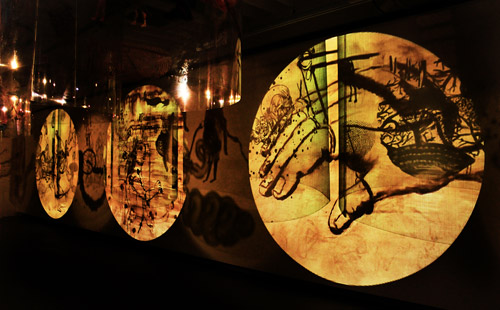
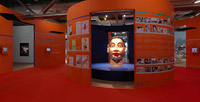
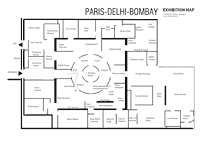
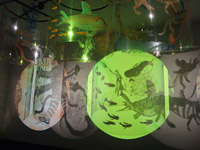
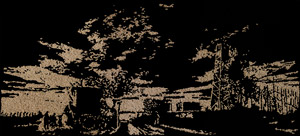

![Alain Bublex, Contribution #2 (Delhi Cold Storage, notes & hypotheses [of work]), 2010-2011 (details)](photos/07-alain-bublex-contribution-2-delhi-cold-storage-2010-2011-200x156.jpg)
![Alain Bublex, Contribution #2 (Delhi Cold Storage, notes & hypotheses [of work]), 2010-2011 (details)](photos/08-alain-bublex-contribution-2-delhi-cold-storage-2010-2011-200x156.jpg)
